2016 Peugeot Expert VU ECO mode
[x] Cancel search: ECO modePage 239 of 520
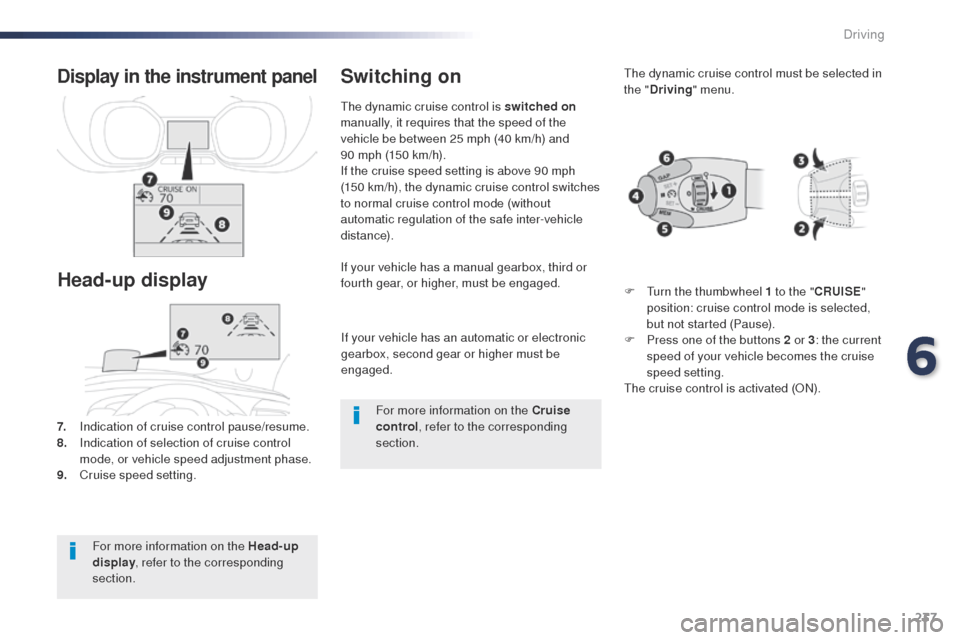
237
If your vehicle has an automatic or electronic
gearbox, second gear or higher must be
engaged.
If your vehicle has a manual gearbox, third or
fourth gear, or higher, must be engaged.
7.
I
ndication of cruise control pause/resume.
8.
I
ndication of selection of cruise control
mode, or vehicle speed adjustment phase.
9.
C
ruise speed setting.
Display in the instrument panel
Head-up display
the dynamic cruise control is switched on
manually, it requires that the speed of the
vehicle be between 25 mph (40 km/h) and
90
mph (150 km/h).
If the cruise speed setting is above 90 mph
(150 km/h), the dynamic cruise control switches
to normal cruise control mode (without
automatic regulation of the safe inter-vehicle
distance).
Switching on
For more information on the Head-up
display , refer to the corresponding
section. For more information on the Cruise
control
, refer to the corresponding
section.
th
e dynamic cruise control must be selected in
the " Driving " menu.
F t
u
rn the thumbwheel 1 to the "
CRUISE"
position: cruise control mode is selected,
but not started (Pause).
F
P
ress one of the buttons 2 or 3
: the current
speed of your vehicle becomes the cruise
speed setting.
th
e cruise control is activated (
oN
).
6
Driving
Page 244 of 520
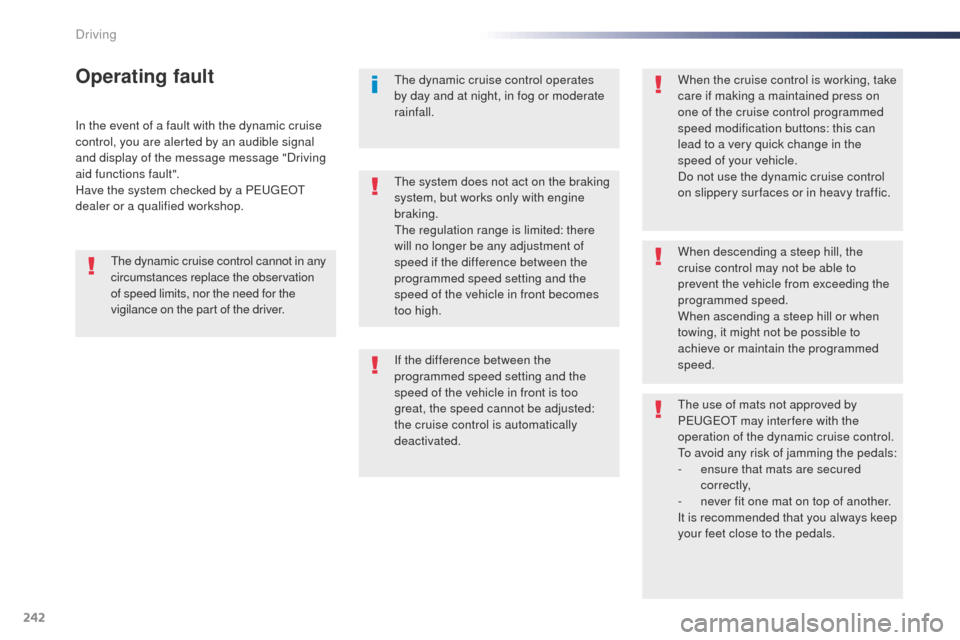
242
In the event of a fault with the dynamic cruise
control, you are alerted by an audible signal
and display of the message message "Driving
aid functions fault".
Have the system checked by a P
e
ugeot
dealer or a qualified workshop.
Operating faultthe dynamic cruise control operates
by day and at night, in fog or moderate
rainfall. When the cruise control is working, take
care if making a maintained press on
one of the cruise control programmed
speed modification buttons: this can
lead to a very quick change in the
speed of your vehicle.
Do not use the dynamic cruise control
on slippery sur faces or in heavy traffic.
When descending a steep hill, the
cruise control may not be able to
prevent the vehicle from exceeding the
programmed speed.
When ascending a steep hill or when
towing, it might not be possible to
achieve or maintain the programmed
speed.
th
e use of mats not approved by
P
e
ugeot may inter fere with the
operation of the dynamic cruise control.
to a
void any risk of jamming the pedals:
-
e
nsure that mats are secured
c o r r e c t l y,
-
n
ever fit one mat on top of another.
It is recommended that you always keep
your feet close to the pedals.
If the difference between the
programmed speed setting and the
speed of the vehicle in front is too
great, the speed cannot be adjusted:
the cruise control is automatically
deactivated.
th
e system does not act on the braking
system, but works only with engine
braking.
th
e regulation range is limited: there
will no longer be any adjustment of
speed if the difference between the
programmed speed setting and the
speed of the vehicle in front becomes
too high.
th
e dynamic cruise control cannot in any
circumstances replace the observation
of speed limits, nor the need for the
vigilance on the part of the driver.
Driving
Page 261 of 520
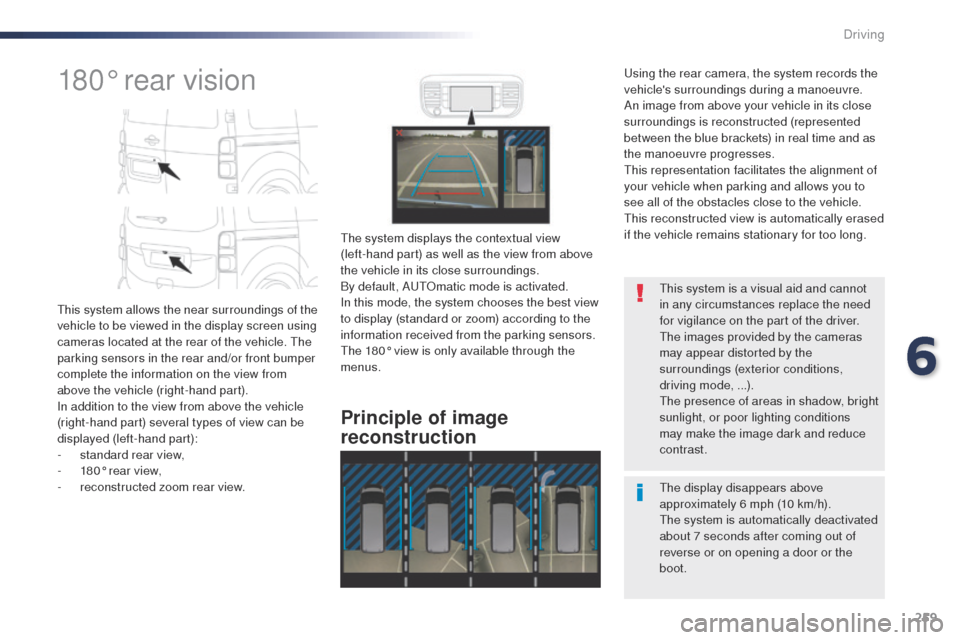
259
180° rear vision
this system allows the near surroundings of the
vehicle to be viewed in the display screen using
cameras located at the rear of the vehicle. t
h
e
parking sensors in the rear and/or front bumper
complete the information on the view from
above the vehicle (right-hand part).
In addition to the view from above the vehicle
(right-hand part) several types of view can be
displayed (left-hand part):
-
s
tandard rear view,
-
1
80° rear view,
-
r
econstructed zoom rear view.
Principle of image
reconstruction
the system displays the contextual view
(left-hand part) as well as the view from above
the vehicle in its close surroundings.
By default, A
u
to
m
atic mode is activated.
In this mode, the system chooses the best view
to display (standard or zoom) according to the
information received from the parking sensors.
th
e 180° view is only available through the
menus.
th
e display disappears above
approximately 6 mph (10 km/h).
th
e system is automatically deactivated
about 7 seconds after coming out of
reverse or on opening a door or the
boot.
th
is system is a visual aid and cannot
in any circumstances replace the need
for vigilance on the part of the driver.
th
e images provided by the cameras
may appear distorted by the
surroundings (exterior conditions,
driving mode, ...).
th
e presence of areas in shadow, bright
sunlight, or poor lighting conditions
may make the image dark and reduce
contrast.
us
ing the rear camera, the system records the
vehicle's surroundings during a manoeuvre.
An image from above your vehicle in its close
surroundings is reconstructed (represented
between the blue brackets) in real time and as
the manoeuvre progresses.
th
is representation facilitates the alignment of
your vehicle when parking and allows you to
see all of the obstacles close to the vehicle.
th
is reconstructed view is automatically erased
if the vehicle remains stationary for too long.
6
Driving
Page 263 of 520

261
Activation
Activation is automatic on engaging reverse.the function is displayed in the touch screen.
to c
lose the window displayed, press on the
red cross at the top left of the screen.
on d
isplay of the sub-menu, select one of the
four views:
"Standard view".
"180° view".
"Zoom view".
"A
u
to
m
o de".
You can choose the display mode at any time
by pressing on this area. Check the cleanliness of the camera
lenses regularly.
Periodically clean the reversing camera
with a soft dry cloth.
"AUTO mode"
this mode is activated by default.us
ing sensors in the rear bumper, the
automatic view allows a change from the rear
view to the view from above as an obstacle is
approached during a manoeuvre.
th
e system is automatically deactivated
when towing a trailer or carrying a
bicycle on the towbar (vehicle fitted with
a towbar installed as recommended by
the manufacturer).
Quick start mode
this mode displays, as quickly as possible, the
contextual view (left-hand part) and the view
from above the vehicle. High pressure jet wash (if muddy, for
example)
When washing your vehicle, do not
place the tip of the lance within 30 cm of
the camera lenses, as otherwise there
is a risk of damaging them.
A message is displayed advising you to check
your vehicle's surroundings before starting the
manoeuvre.
6
Driving
Page 272 of 520
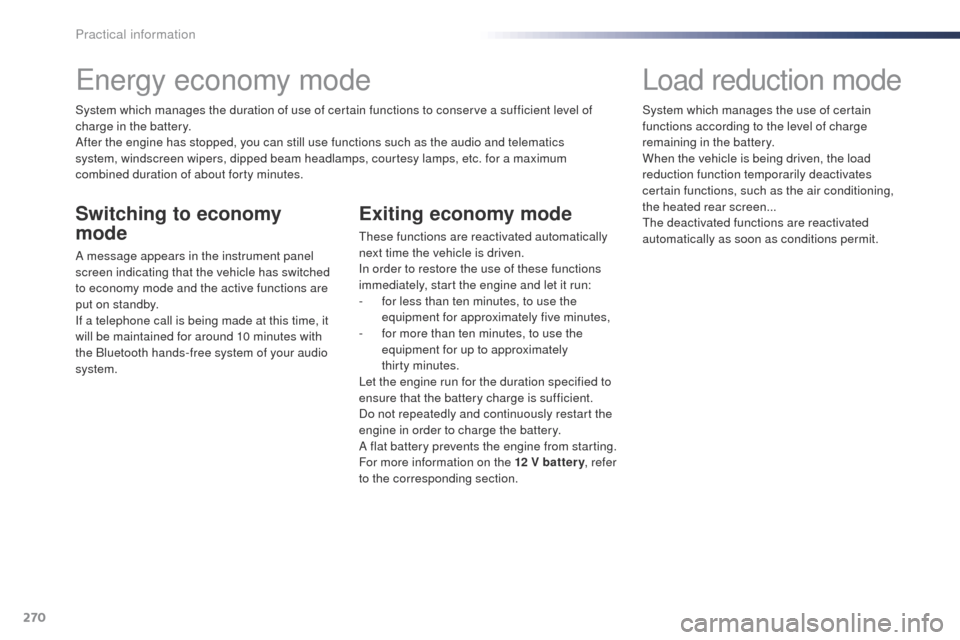
270
energy economy mode
System which manages the duration of use of certain functions to conserve a sufficient level of
charge in the battery.
After the engine has stopped, you can still use functions such as the audio and telematics
system, windscreen wipers, dipped beam headlamps, courtesy lamps, etc. for a maximum
combined duration of about forty minutes.
Switching to economy
mode
A message appears in the instrument panel
screen indicating that the vehicle has switched
to economy mode and the active functions are
put on standby.
If a telephone call is being made at this time, it
will be maintained for around 10 minutes with
the Bluetooth hands-free system of your audio
system.
Exiting economy mode
these functions are reactivated automatically
next time the vehicle is driven.
In order to restore the use of these functions
immediately, start the engine and let it run:
-
f
or less than ten minutes, to use the
equipment for approximately five minutes,
-
f
or more than ten minutes, to use the
equipment for up to approximately
thirty
minutes.
Let the engine run for the duration specified to
ensure that the battery charge is sufficient.
Do not repeatedly and continuously restart the
engine in order to charge the battery.
A flat battery prevents the engine from starting.
For more information on the 12 V batter y , refer
to the corresponding section.
Load reduction mode
System which manages the use of certain
functions according to the level of charge
remaining in the battery.
When the vehicle is being driven, the load
reduction function temporarily deactivates
certain functions, such as the air conditioning,
the heated rear screen...
th
e deactivated functions are reactivated
automatically as soon as conditions permit.
Practical information
Page 274 of 520
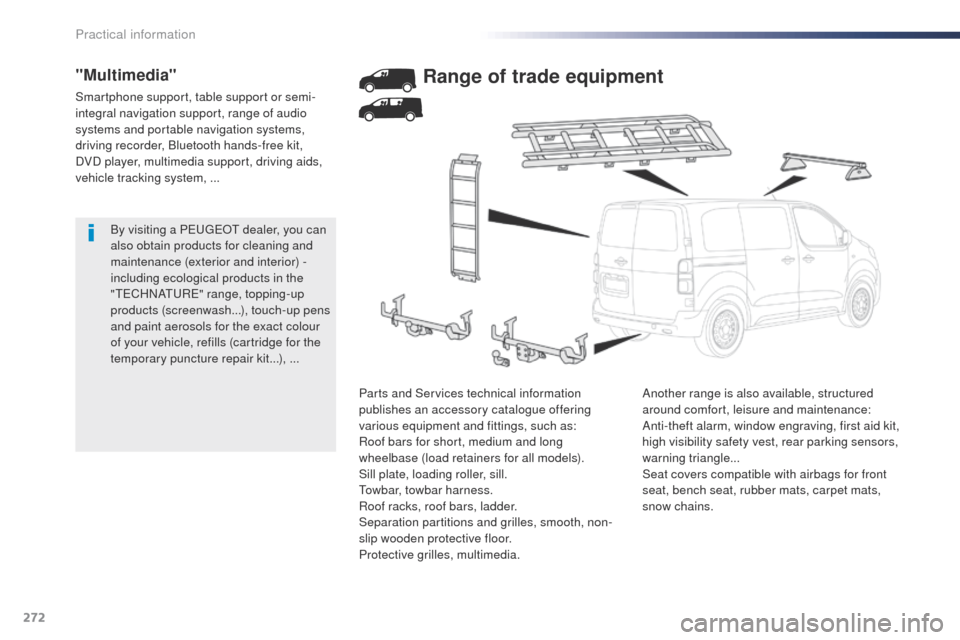
272
By visiting a Peugeot dealer, you can
also obtain products for cleaning and
maintenance (exterior and interior)
-
including ecological products in the
"
t
e
C
HNA
t
u
Re" r
ange, topping-up
products (screenwash...), touch-up pens
and paint aerosols for the exact colour
of your vehicle, refills (cartridge for the
temporary puncture repair kit...), ...
"Multimedia"
Smartphone support, table support or semi-
integral navigation support, range of audio
systems and portable navigation systems,
driving recorder, Bluetooth hands-free kit,
DVD
player, multimedia support, driving aids,
vehicle tracking system,
...
Range of trade equipment
Another range is also available, structured
around comfort, leisure and maintenance:
Anti-theft alarm, window engraving, first aid kit,
high visibility safety vest, rear parking sensors,
warning triangle...
Seat covers compatible with airbags for front
seat, bench seat, rubber mats, carpet mats,
snow chains.
Parts and Services technical information
publishes an accessory catalogue offering
various equipment and fittings, such as:
Roof bars for short, medium and long
wheelbase (load retainers for all models).
Sill plate, loading roller, sill.
to
wbar, towbar harness.
Roof racks, roof bars, ladder.
Separation partitions and grilles, smooth, non-
slip wooden protective floor.
Protective grilles, multimedia.
Practical information
Page 343 of 520
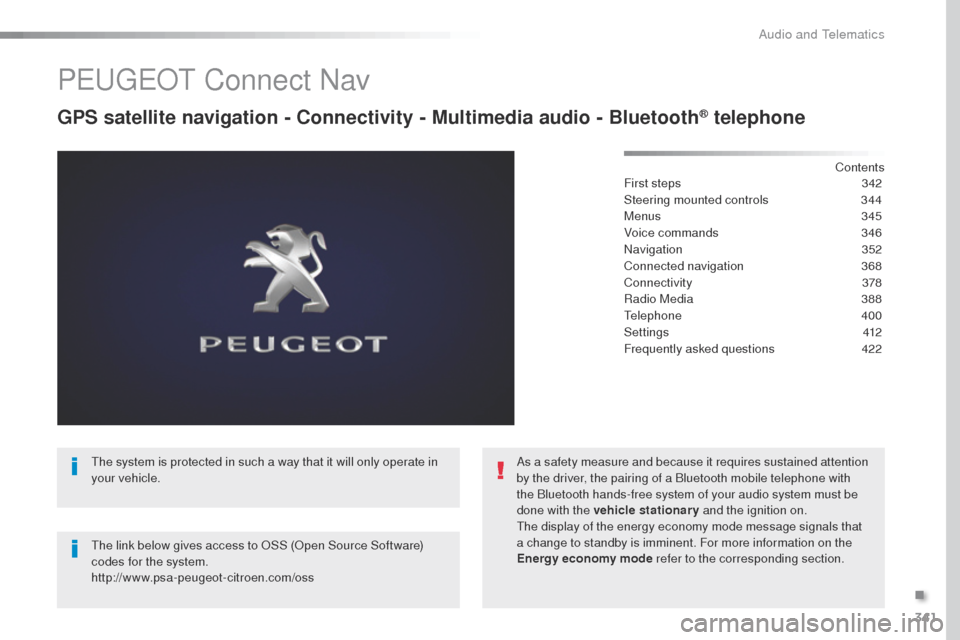
341
Peugeot Connect Nav
GPS satellite navigation - Connectivity - Multimedia audio - Bluetooth® telephone
Contents
First steps
3 42
Steering mounted controls
3
44
Menus
345
Voice commands
3
46
Navigation
3
52
Connected navigation
3
68
Connectivity
3
78
Radio Media
3
88
te
lephone
400
Settings
4
12
Frequently asked questions
4
22
th
e system is protected in such a way that it will only operate in
your vehicle.
th
e link below gives access to
o
S
S (
op
en Source Software)
codes for the system.
http://www.psa-peugeot-citroen.com/oss As a safety measure and because it requires sustained attention
by the driver, the pairing of a Bluetooth mobile telephone with
the Bluetooth hands-free system of your audio system must be
done with the vehicle stationary
and the ignition on.
th
e display of the energy economy mode message signals that
a change to standby is imminent. For more information on the
Energy economy mode refer to the corresponding section.
.
Audio and telematics
Page 348 of 520
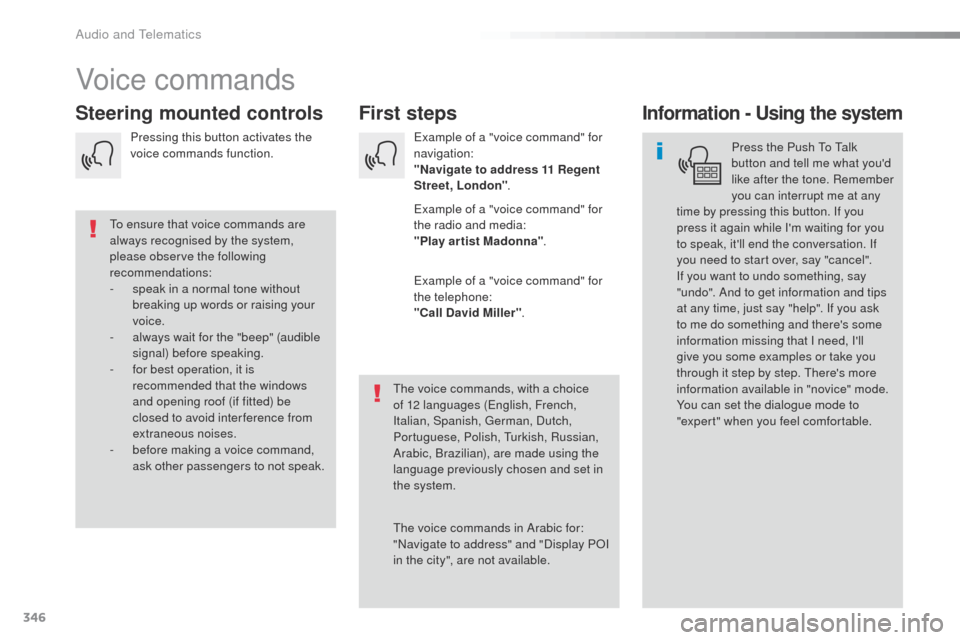
346
Voice commands
First steps
Steering mounted controlsInformation - Using the system
Press the Push to ta lk
button and tell me what you'd
like after the tone. Remember
you can interrupt me at any
time by pressing this button. If you
press it again while I'm waiting for you
to speak, it'll end the conversation. If
you need to start over, say "cancel".
If you want to undo something, say
"undo". And to get information and tips
at any time, just say "help". If you ask
to me do something and there's some
information missing that I need, I'll
give you some examples or take you
through it step by step.
t
h
ere's more
information available in "novice" mode.
You can set the dialogue mode to
"expert" when you feel comfortable.
to e
nsure that voice commands are
always recognised by the system,
please observe the following
recommendations:
-
s
peak in a normal tone without
breaking up words or raising your
voice.
-
a
lways wait for the "beep" (audible
signal) before speaking.
-
f
or best operation, it is
recommended that the windows
and opening roof (if fitted) be
closed to avoid inter ference from
extraneous noises.
-
b
efore making a voice command,
ask other passengers to not speak.
th
e voice commands, with a choice
of 12 languages (
en
glish, French,
Italian, Spanish,
g
e
rman, Dutch,
Portuguese, Polish,
t
u
rkish, Russian,
Arabic, Brazilian), are made using the
language previously chosen and set in
the system.
th
e voice commands in Arabic for:
"Navigate to address" and "Display P
oI
i
n the city", are not available.ex
ample of a "voice command" for
navigation:
"Navigate to address 11 Regent
Street, London ".
ex
ample of a "voice command" for
the radio and media:
"Play ar tist Madonna" .
ex
ample of a "voice command" for
the telephone:
"Call David Miller" .
Pressing this button activates the
voice commands function.
Audio and telematics